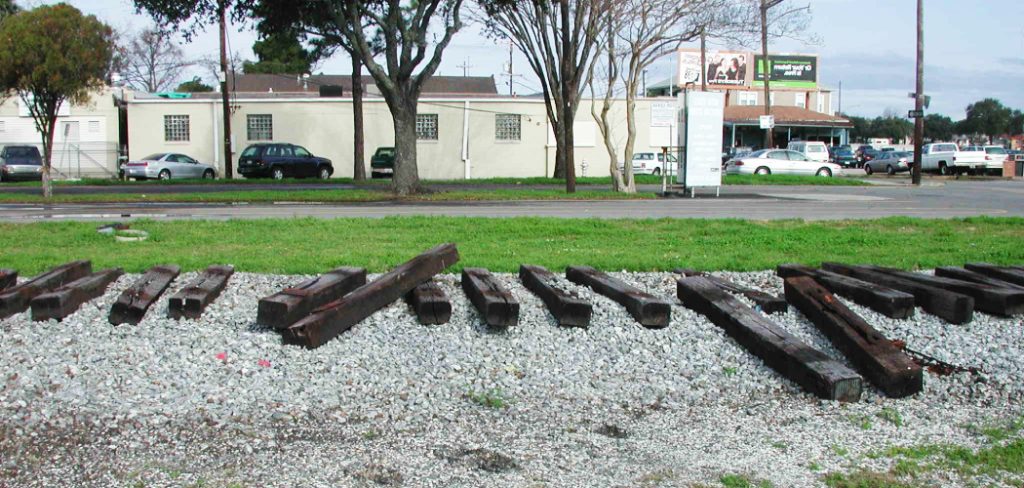You can use old railroad ties in different ways. But whatever you build, you must know how to attach railroad ties properly. Otherwise, these heavy railroad ties will not stand. Due to this, accidents can happen.

There are several methods of attaching them, but the most popular is to screw them together. Many have claimed that it is quite effective. I have discussed screw railroad ties in detail in the article and hope you will benefit from them.
Table of Contents
- Step 1: Place Railroad Ties
- Step 2: Cut the Ties
- Step 3: Hold Levels of Ties Together
- Step 4: Drill Hole (If Needed)
- Step 5: Install the Screw
- Step 6: Check the Railroad Ties
- Optional: Use a Base Plate
- What Are Railroad Ties?
- Type of Railroad Ties
- Type of Screw Used for Railroad Ties
- Where Can I Buy Used Railroad Ties?
- Conclusion
Step 1: Place Railroad Ties
Railroad ties need to be leveled. The soil of that place is removed and leveled with a spade. It weighs from 100 to 300 lbs, which is difficult to move manually. So a wheeled vehicle will be required to bring the tie to the specified place. Then put the ties in place.
Step 2: Cut the Ties
You may need to shorten the piece for presentation in a certain place, in which case you use a chain saw petrol or use heavy wood cutter machines to cut it. Ties are somewhat thick and hard to cut with a normal handsaw. Use a measurement tape to measure the tie.
Step 3: Hold Levels of Ties Together
Ties may move out of place while working. So put a rod or wood around the tie before screwing. Once stuck in it, they will never be able to move.
Step 4: Drill Hole (If Needed)
The wood of railway ties is usually very hard, so it is very difficult to install screws or rail spikes directly; applying force can bend them, or the wood will crack, so you can make your job easier by using Drill machine.
If you want to connect one tie to another crosswise and place it on the ground, you must drill the crosswise drill. When drilling, you must drill slightly away from the ends of the ties, or they may crack under pressure.
Step 5: Install the Screw
After drilling the hole with the drill machine, the long screw should be inserted and tightened with the nut. Measure the length of the screw with a measuring tape along the drilled hole. You need to buy screws & nuts according to that size.
In this way, you can remove the adjacent rods or wood after tightening the screws well wherever you have drilled.
Step 6: Check the Railroad Ties
Make sure your ties are set up correctly, and if a pair of ties are unsafe, you can re-drill them using rail spikes or rods.
Optional: Use a Base Plate
If the wobble remains after re-attaching the rail with spikes or rods, a good solution is to use a base plate. It allows you to screw two ties from the top or side.
What Are Railroad Ties?
A railway tie is called a crosstie, railway tie, or railway sleeper. They keep the rail tracks straight and spread the pressure of the moving train evenly between them. Bands can be about 8 feet 6 inches long, 8 to 9 inches wide, and 2.5 to 7 inches thick. They have a lifespan of 20 to 30 years or more, depending on the environment and wood quality, after which they need to be replaced.
Type of Railroad Ties
Wooden Ties
Railroad Ties made of wood have been used since ancient times. Although many types of railroad tiles are manufactured nowadays, a large amount of wood is still used.
Hardwood is mostly used to make railway tiles from wood. The most famous among them are Cedar, oak, jarrah, karri, etc. These hardwoods are able to survive for about 50 years.
Railroad ties usually range from 100-200 pounds depending on the type, but their weight decreases with age.
Concrete Ties
At present, concrete ties are used more than wooden railway ties in Asia and Europe because concrete railroad ties are becoming dependent on reducing the use of trees.
Steel Ties
In railways, steel ties are found on lines used for heavy loads and are placed at certain locations. Steel ties use 60% less ballast than concrete and 45% less ballast than wood.
These ties are capable of serving more than 50 years and are fully recyclable.
(Source: https://en.wikipedia.org/wiki/Railroad_tie#Concrete)
Plastic Ties
These plastic railroad ties are made using recycled plastic composite and are also recyclable. It lasts longer than wood (More than 50 years). Another good point is that it is not affected by the weather. It weighs between 200 and 280 pounds depending on size.
Type of Screw Used for Railroad Ties
Several types of fasteners available in the market can be used with railroads, such as – square head fish bolt, anchor bolt, T bolt, cup head oval neck fish bolt, BHON track bolt, Etc. These fasteners can be used with single or double-shoulder tie plates to attach railroad ties.
Where Can I Buy Used Railroad Ties?
You can buy them from several online stores just by searching online, and you can also find chain stores in the city. You can also find it at Home Depot, Estate Or Garage Sales, Lowe’s, Bridgewell, Facebook Marketplace, and local Craigs.
Consider the grade and age of the tie when purchasing.
Conclusion
Hope you got your answer to our article. If you have any questions, you can comment. I look forward to your experience or any good suggestions. Have a nice day.
